Synthesis of Iron on Carbon Foam for Use in the Removal of Phenol from Aqueous Solutions
Abstract
1. Introduction
2. Results and Discussion
2.1. Characterisation of Carbon Foam
2.2. Effect of Initial Concentration
2.3. The Effect of Time on Adsorption
2.4. Mechanism
2.5. Kinetic Modelling
2.6. Intraparticle Diffusion
2.7. Equilibrium Adsorption
3. Materials and Methods
3.1. Materials and Chemicals
3.2. Preparation of Carbon Foam
3.3. Adsorption of Phenol
4. Conclusions
Author Contributions
Funding
Institutional Review Board Statement
Informed Consent Statement
Data Availability Statement
Conflicts of Interest
Sample Availability
References
- Fathy Mubarak, M.; Maher Ahmed, A.; Saad Gabr, S. Nanoporous carbon materials toward phenolic compounds adsorption. In Nanopores; IntechOpen: London, UK, 2021. [Google Scholar]
- Bagheri, B.; Hosseini, S.A.; Mehrizadeh, H. A Comparison of the Catalytic Activity of Cu-X2 (X = Mn, Co) Nano Mixed Oxides toward Phenol Remediation from Wastewater by Catalytic Wet Peroxide Oxidation. J. Water Environ. Nanotechnol. 2020, 5, 139–146. [Google Scholar]
- Fierro, V.; Torné-Fernández, V.; Montané, D.; Celzard, A. Adsorption of phenol onto activated carbons having different textural and surface properties. Microporous Mesoporous Mater. 2007, 111, 276–284. [Google Scholar] [CrossRef]
- Kandisa, R.V.; Saibaba, K.N.; Shaik, K.B.; Gopinath, R. Dye Removal by Adsorption: A Review. J. Bioremediat. Biodegrad. 2016, 7, 371. [Google Scholar] [CrossRef]
- Adeleye, A.S.; Conway, J.R.; Garner, K.; Huang, Y.; Su, Y.; Keller, A.A. Engineered nanomaterials for water treatment and remediation: Costs, benefits, and applicability. J. Chem. Eng. 2016, 286, 640–662. [Google Scholar]
- Villegas LG, C.; Mashhadi, N.; Chen, M.; Mukherjee, D.; Taylor, K.E.; Biswas, N. A Short Review of Techniques for Phenol Removal from Wastewater. Curr. Pollut. Rep. 2016, 2, 157–167. [Google Scholar] [CrossRef]
- Asencios, Y.J.O.; Lourenço, V.S.; Carvalho, W.A. Removal of phenol in seawater by heterogeneous photocatalysis using activated carbon materials modified with TiO2. Catalysis Today 2022, 388–389, 247–258. [Google Scholar] [CrossRef]
- Pirillo, S.; Pedroni, V.; Rueda, E.; Ferreira, M.L. Elimination of dyes from aqueous solutions using iron oxides and chitosan as adsorbents: A comparative study. Química Nova 2009, 35, 1239–1244. [Google Scholar] [CrossRef]
- Mohammadi, S.; Kargari, A.; Sanaeepur, H.; Abbassian, K.; Najafi, A.; Mofarrah, E. Phenol removal from industrial wastewaters: A short review. Desalination Water Treat. 2015, 53, 2215–2234. [Google Scholar] [CrossRef]
- Oyelude, E.O.; Owusu, U.R. Adsorption of Methylene Blue from Aqueous Solution Using Acid Modified Calotropis Procera Leaf Powder. J. Appl. Sci. Environ. Sanit. 2011, 6, 477–484. [Google Scholar]
- Shahid, M.; Farooqi, Z.H.; Begum, R.; Arif, M.; Irfan, A.; Azam, M. Extraction of cobalt ions from aqueous solution by microgels for in-situ fabrication of cobalt nanoparticles to degrade toxic dyes: A two fold-environmental application. Chem. Phys. Lett. 2020, 754, 137645. [Google Scholar] [CrossRef]
- Turco, A.; Monteduro, A.G.; Mazzotta, E.; Maruccio, G.; Malitesta, C. An Innovative Porous Nanocomposite Material for the Removal of Phenolic Compounds from Aqueous Solutions. Nanomaterials 2018, 8, 334. [Google Scholar] [CrossRef] [PubMed]
- Gupta, S.; Babu, B.V. Experimental, kinetic, equilibrium and regeneration studies for adsorption of Cr(VI) from aqueous solutions using low cost adsorbent (activated flyash). Desalination Water Treat. 2010, 20, 168–178. [Google Scholar] [CrossRef]
- Ho, Y.S.; McKay, G. Kinetic models for the sorption of dye from aqueous solution by wood. Process. Saf. Environ. Prot. 1998, 76, 183–191. [Google Scholar] [CrossRef]
- Arif, M. Complete life of cobalt nanoparticles loaded into cross-linked organic polymers: A review. R. Soc. Chem. 2022, 12, 15447. [Google Scholar] [CrossRef] [PubMed]
- Negrescu, A.M.; Killian, M.S.; Raghu, S.N.; Schmuki, P.; Mazare, A.; Cimpean, A. Metal Oxide Nano-particles as an Adsorbent for Removal of Heavy Metals. J. Adv. Chem. Eng. 2015, 5, 274. [Google Scholar]
- Arif, M.; Munawar, K.; Ali, S.; Raza, H.; Ashfaq, M. Synthesis and Optical Study of Sensitive and Selective Detection of Fe(III) ions Based on Solvents. Egytian J. Chem. 2020, 63, 4029–4038. [Google Scholar] [CrossRef]
- Talbot, D.; Queiros Campos, J.; Checa-Fernandez, B.L.; Marins, J.A.; Lomenech, C.; Hurel, C.; Godeau, G.D.; Raboisson-Michel, M.; Verger-Dubois, G.; Obeid, L.; et al. Adsorption of Organic Dyes on Magnetic Iron Oxide Nanoparticles. Part I: Mechanisms and Adsorption-Induced Nanoparticle Agglomeration. ACS Omega 2021, 6, 19086–19098. [Google Scholar] [CrossRef] [PubMed]
- Zygmunt Marczenko, M.B. Separation, Preconcentration and Spectrophotometry in Inorganic Analysis; Elsevier: Amsterdam, The Netherlands, 2000; Volume 10. [Google Scholar]
- Taromi, A.A.; Kaliaguine, S. Hydrodeoxygenation of triglycerides over reduced mesostructured Ni/γ- alumina catalysts prepared via one-pot sol-gel route for green diesel production. Appl. Catal. 2018, 558, 140–149. [Google Scholar] [CrossRef]
- Rendo, D. Adsorption of Methylene Blue Dye using Fe3O4 Magnetized Natural Zeolite Adsorbent. J. Kim. Sains Apl. 2021, 24, 51–57. [Google Scholar] [CrossRef]
- Selvi, P.P. Mass Transfer Enhancement for CO2 Absorption in Structured Packed Absorption Column. J. Chem. Soc. Pak. 2019, 41, 820–824. [Google Scholar]
- Asokan, K. Mass Transfer Concepts; University Press: New Delhi, India, 2011. [Google Scholar]
- El-Sayed, Y.; Bandosz, T.J. A Study of Acetaldehyde Adsorption on Activated Carbons. J. Colloid Interface Sci. 2001, 242, 44–51. [Google Scholar] [CrossRef]
- Luz-Asunción, M.D.; Sánchez-Mendieta, V.; Martínez-Hernández, A.L.; Castaño, V.M.; Velasco-Santos, C. Adsorption of phenol from aqueous solutions by carbon nanomaterials of one and two dimensions: Kinetic and equilibrium studies. J. Nanomater. 2015, 16, 422. [Google Scholar] [CrossRef]
- Weber, W.J.; Morris, J.C. Kinetics of Adsorption on Carbon from Solution. J. Sanit. Eng. Div. 1963, 89, 31–59. [Google Scholar] [CrossRef]
- Banat, F.; Al-Bashir, B.; Al-Asheh, S.; Hayajneh, O. Adsorption of Phenol by Bentonite. Environ. Pollut. 2000, 107, 391–398. [Google Scholar] [CrossRef] [PubMed]
- El Maguana, Y.; Elhadiri, N.; Bouchdoug, M.; Benchanaa, M.; Jaouad, A. Activated Carbon from Prickly Pear Seed Cake: Optimization of Preparation Conditions Using Experimental Design and Its Application in Dye Removal. Int. J. Chem. Eng. 2019, 2019, 8621951. [Google Scholar] [CrossRef]
- Medjor, W.; Wepuaka, C.; Godwill, S. Spectrophotometric Determination of Phenol in Natural Waters by Trichloromethane Extraction Method after Steam Distillation. Int. Res. J. Pure Appl. Chem. 2015, 7, 150–156. [Google Scholar] [CrossRef]

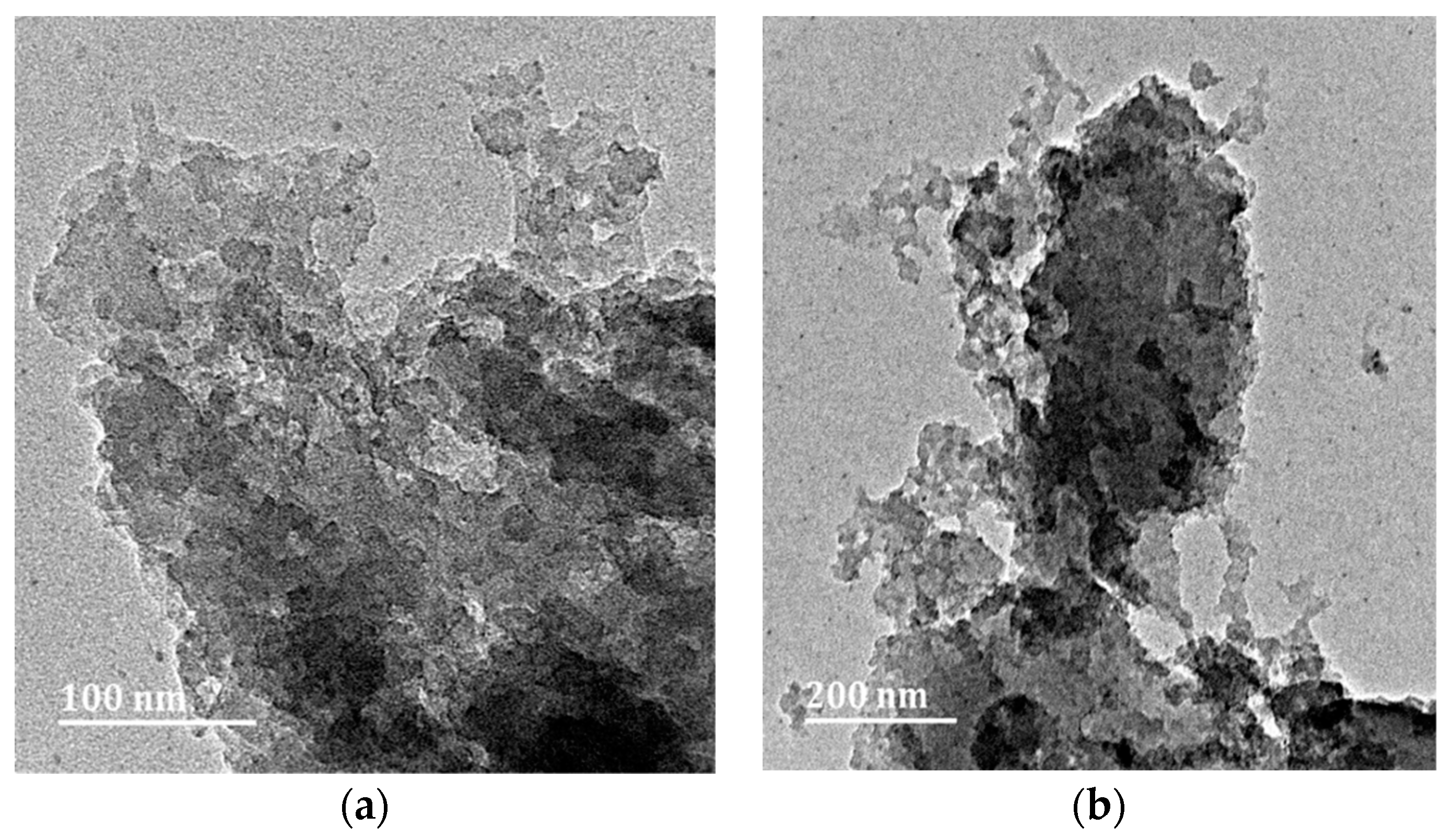
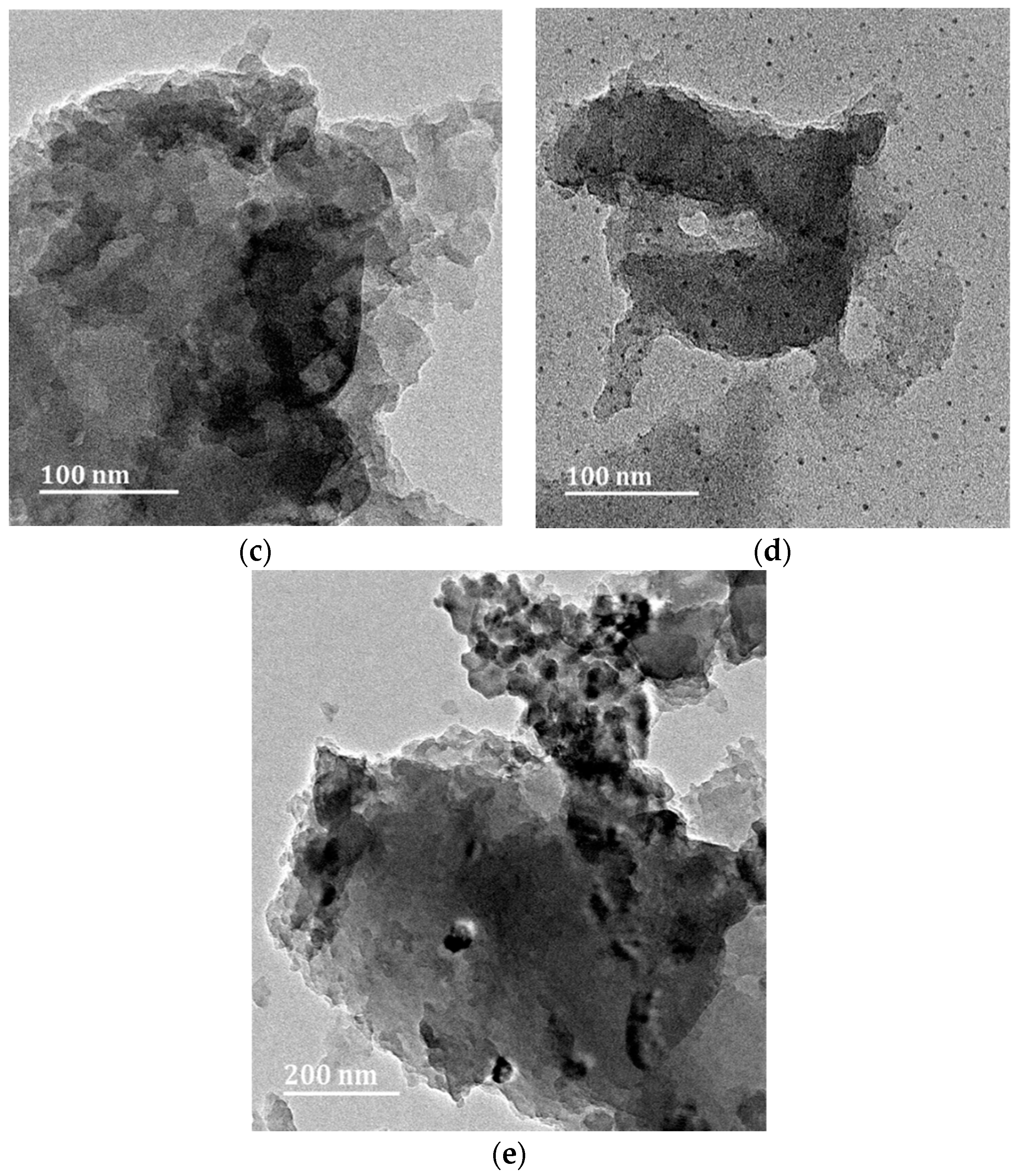
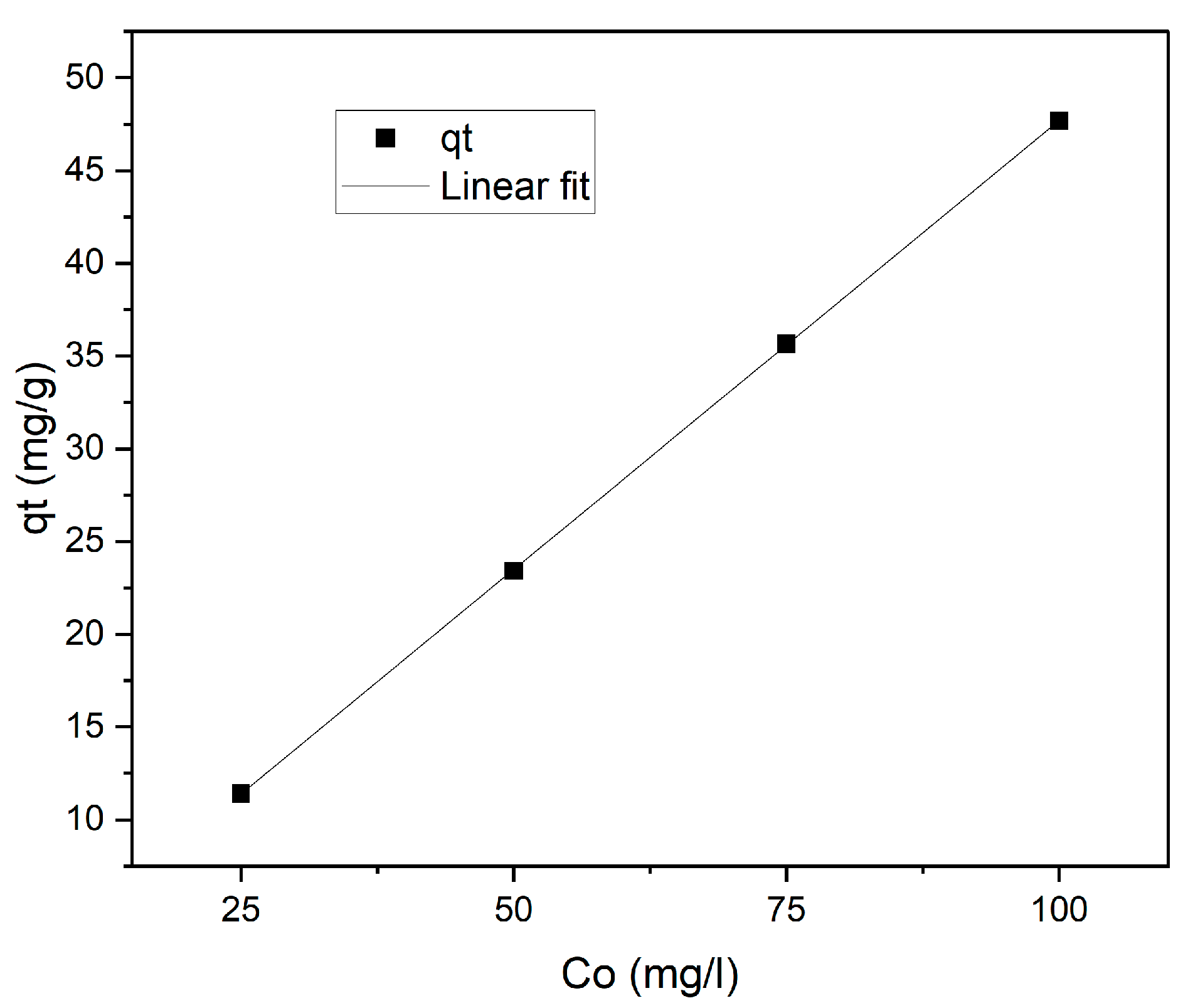

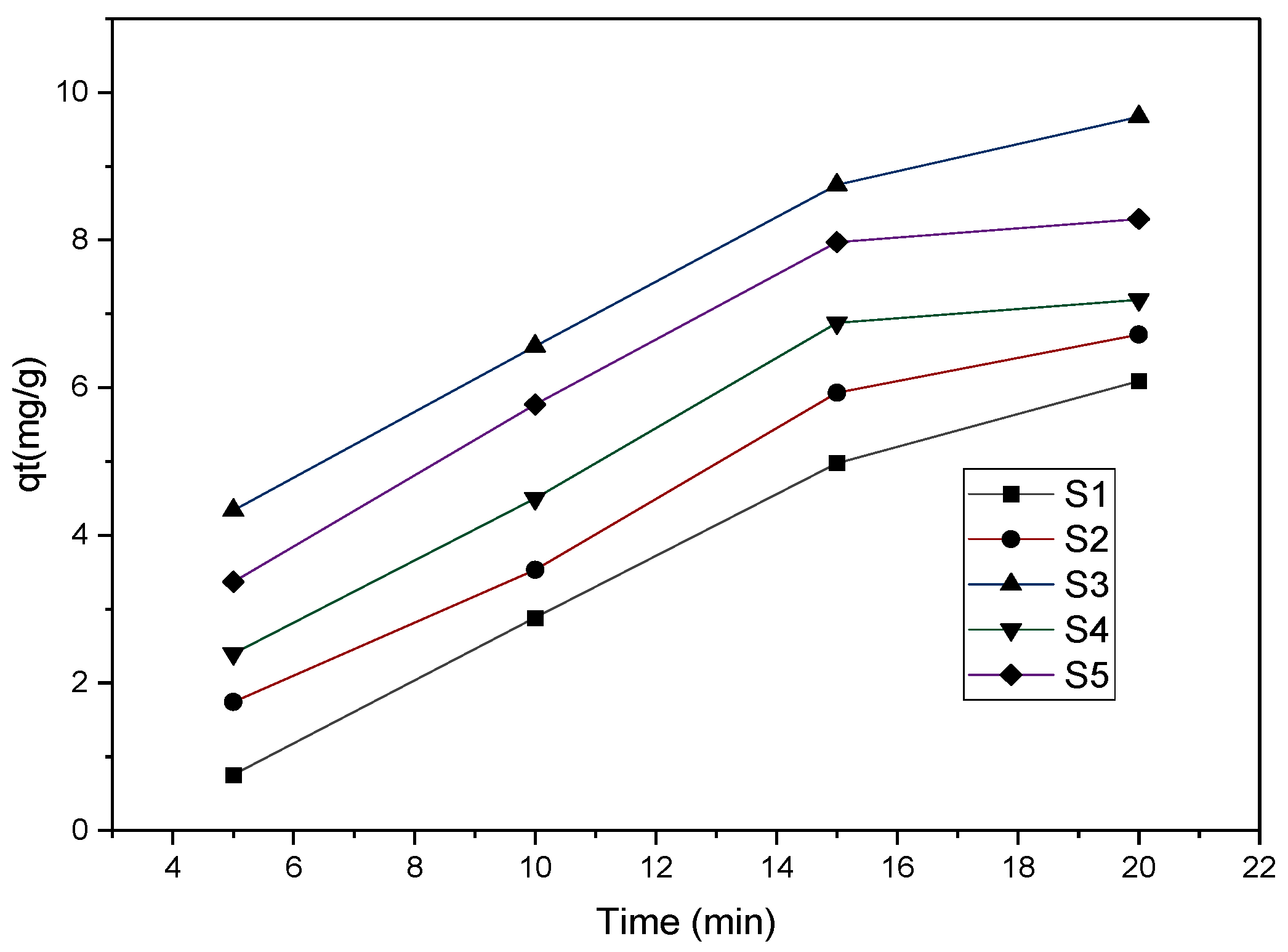
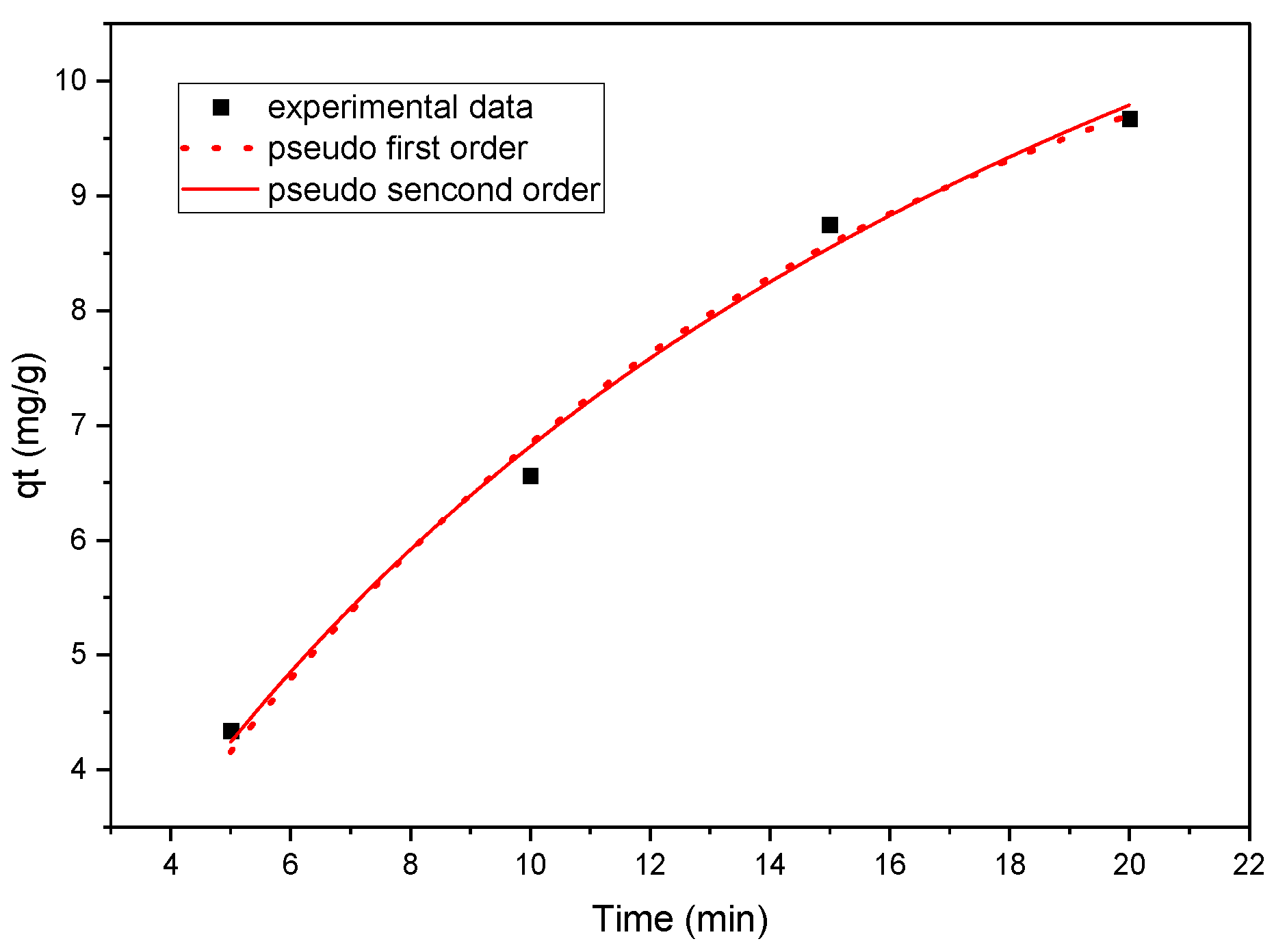
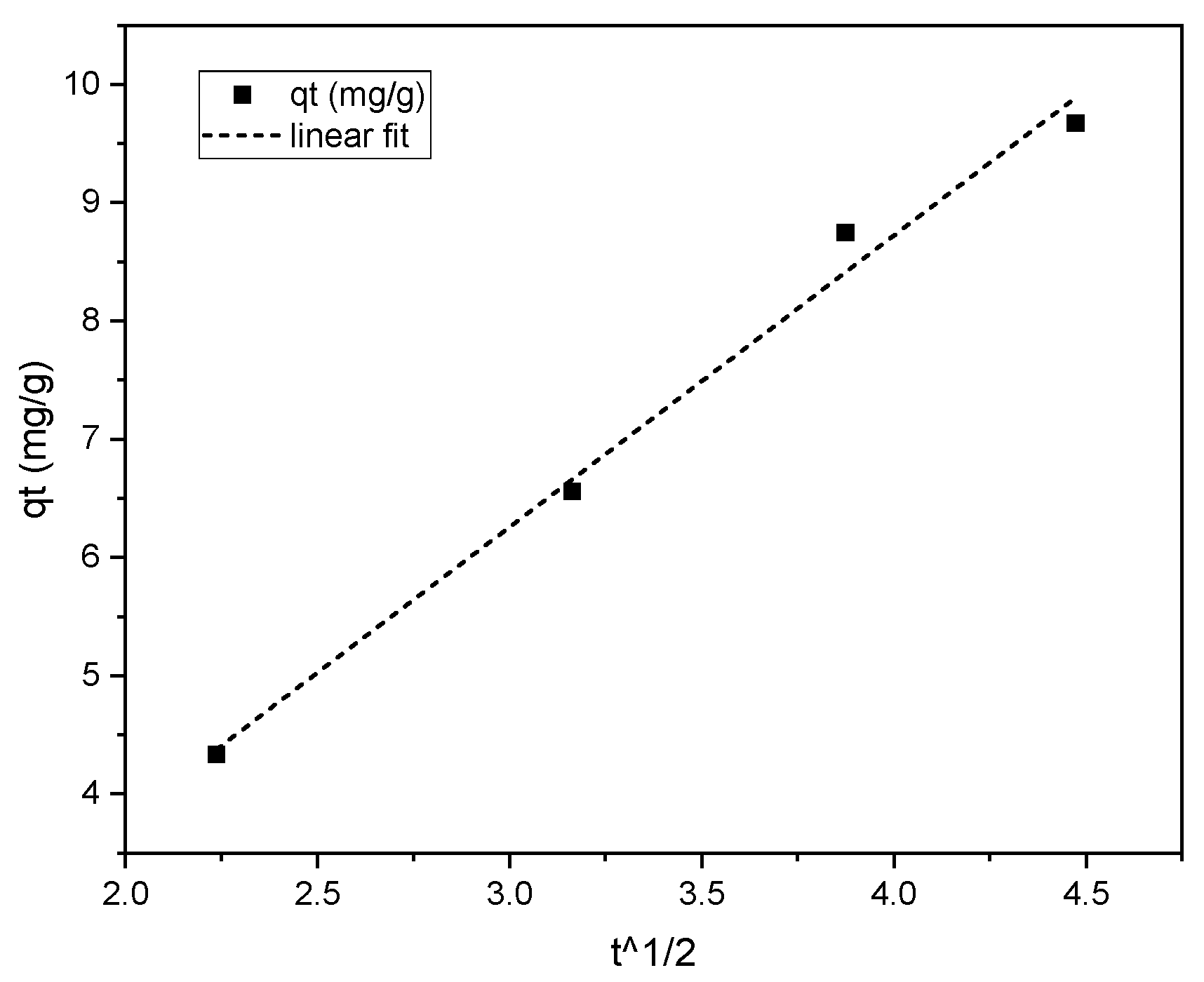
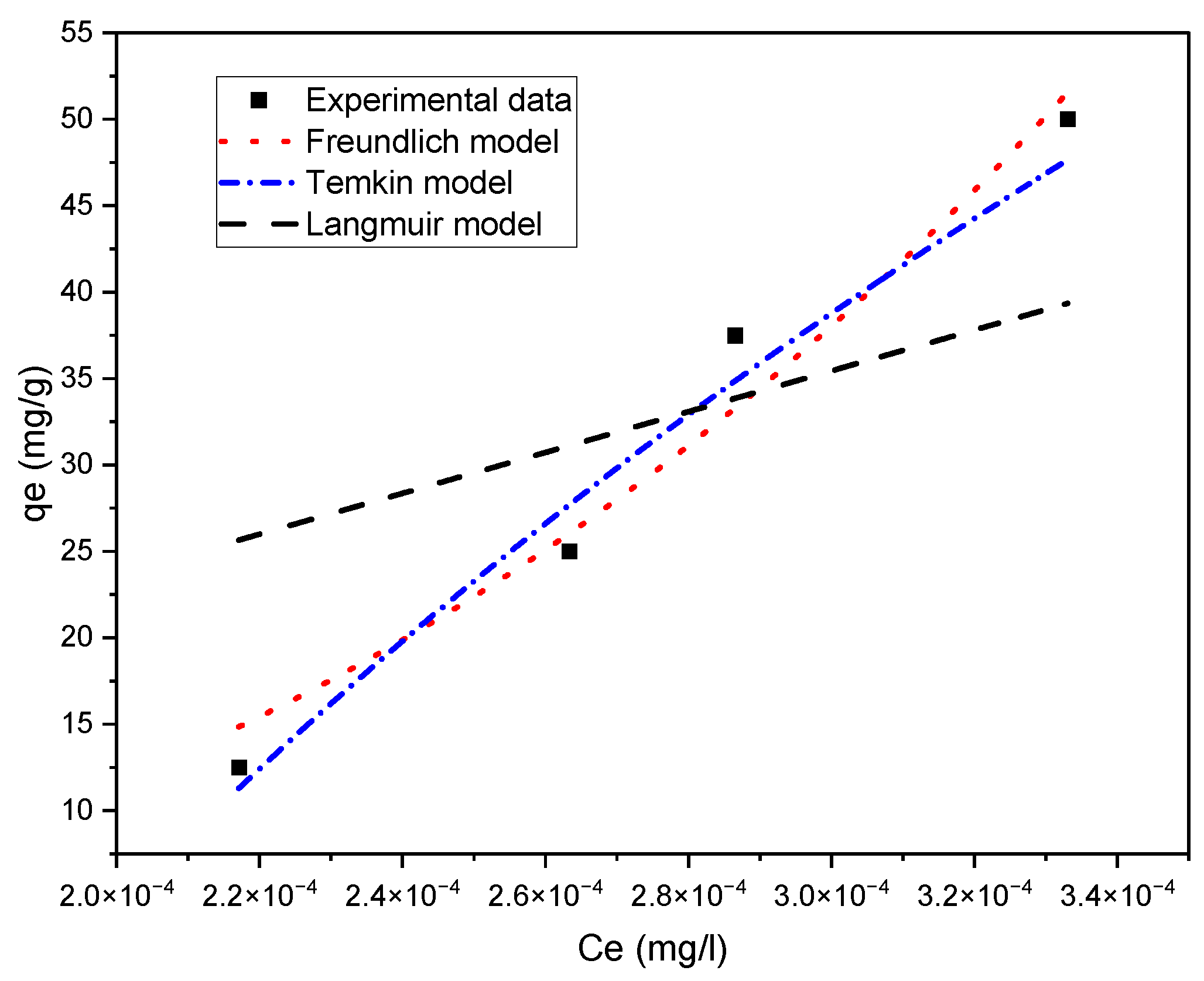
| Exp. qe | Calc. qe | K1 | R2 | |
|---|---|---|---|---|
| Sample 1 | 39.99 × 102 | 7.64 × 10−8 | 0.953 | |
| Sample 2 | 7.3 | 26.21 | 0.015 | 0.974 |
| Sample 3 | 6.5 | 11.76 | 0.872 | 0.992 |
| Sample 4 | 9.8 | 11.84 | 0.050 | 0.963 |
| Sample 5 | 8.5 | 10.74 | 0.080 | 0.976 |
| Exp. qe | Calc. qe | K2 | R2 | |
|---|---|---|---|---|
| Sample 1 | 46.54 × 102 | 1.42 × 10−8 | 0.95 | |
| Sample 2 | 7.3 | 50.49 | 1.58 × 10−4 | 0.97 |
| Sample 3 | 6.5 | 17.22 | 3.79 × 10−4 | 0.99 |
| Sample 4 | 9.8 | 19.88 | 1.54 × 10−3 | 0.96 |
| Sample 5 | 8.5 | 16.34 | 3.41 × 10−3 | 0.97 |
| Sample | Temkin | Freundlich | Langmuir | ||||||
|---|---|---|---|---|---|---|---|---|---|
| b | KT | R2 | n | KF | R2 | qm | KL | R2 | |
| 1 | 38.76 | 7920.14 | 0.98 | 1.97 | 16,564.30 | 0.91 | 82750.9 | 1.96 | 0.78 |
| 2 | 30.89 | 5480.35 | 0.94 | 2.35 | 60,792.30 | 0.87 | 88,020.60 | 1.19 | 0.66 |
| 3 | 29.16 | 5260.43 | 0.98 | 2.91 | 401,434.60 | 0.97 | 105,489.00 | 1.12 | 0.61 |
| 4 | 24.53 | 4494.55 | 0.97 | 2.99 | 577,825.00 | 0.93 | 159,254.50 | 0.67 | 0.52 |
| 5 | 23.1 | 4075.37 | 0.94 | 2.92 | 252,312.60 | 0.87 | 83,231.50 | 1.27 | 0.55 |
| Sample 1 | Sample 2 | Sample 3 | Sample 4 | Sample 5 |
|---|---|---|---|---|
| Magnetite | 3 g pure iron | 3 g iron sponge dissolved in nitric acid | 1 g iron sponge dissolved in nitric acid | 2 g of iron sponge dissolved in nitric acid |
Disclaimer/Publisher’s Note: The statements, opinions and data contained in all publications are solely those of the individual author(s) and contributor(s) and not of MDPI and/or the editor(s). MDPI and/or the editor(s) disclaim responsibility for any injury to people or property resulting from any ideas, methods, instructions or products referred to in the content. |
© 2023 by the authors. Licensee MDPI, Basel, Switzerland. This article is an open access article distributed under the terms and conditions of the Creative Commons Attribution (CC BY) license (https://creativecommons.org/licenses/by/4.0/).
Share and Cite
Khumalo, S.P.-G.; Lokhat, D.; Anwar, C.J.-T.; Reddy, H. Synthesis of Iron on Carbon Foam for Use in the Removal of Phenol from Aqueous Solutions. Molecules 2023, 28, 1272. https://doi.org/10.3390/molecules28031272
Khumalo SP-G, Lokhat D, Anwar CJ-T, Reddy H. Synthesis of Iron on Carbon Foam for Use in the Removal of Phenol from Aqueous Solutions. Molecules. 2023; 28(3):1272. https://doi.org/10.3390/molecules28031272
Chicago/Turabian StyleKhumalo, Siphesihle Praise-God, David Lokhat, Chante Jasmine-Tre Anwar, and Huvin Reddy. 2023. "Synthesis of Iron on Carbon Foam for Use in the Removal of Phenol from Aqueous Solutions" Molecules 28, no. 3: 1272. https://doi.org/10.3390/molecules28031272
APA StyleKhumalo, S. P.-G., Lokhat, D., Anwar, C. J.-T., & Reddy, H. (2023). Synthesis of Iron on Carbon Foam for Use in the Removal of Phenol from Aqueous Solutions. Molecules, 28(3), 1272. https://doi.org/10.3390/molecules28031272







